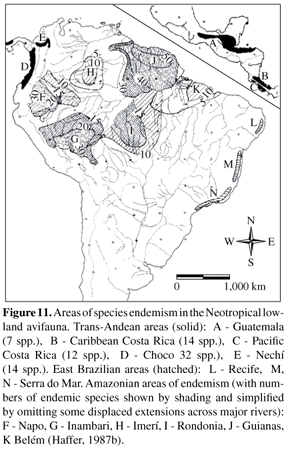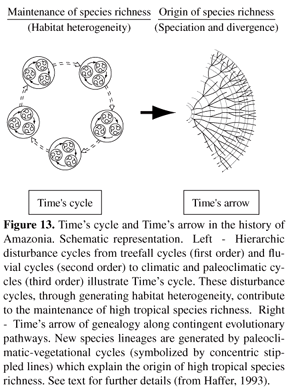The main hypotheses proposed to explain barrier formation separating populations and causing the differentiation of species in Amazonia during the course of geological history are based on different factors, as follow: (1) Changes in the distribution of land and sea or in the landscape due to tectonic movements or sea level fluctuations (Paleogeography hypothesis), (2) the barrier effect of Amazonian rivers (River hypothesis), (3) a combination of the barrier effect of broad rivers and vegetational changes in northern and southern Amazonia (River-refuge hypothesis), (4) the isolation of humid rainforest blocks near areas of surface relief in the periphery of Amazonia separated by dry forests, savannas and other intermediate vegetation types during dry climatic periods of the Tertiary and Quaternary (Refuge hypothesis), (5) changes in canopy-density due to climatic reversals (Canopy-density hypothesis) (6) the isolation and speciation of animal populations in small montane habitat pockets around Amazonia due to climatic fluctuations without major vegetational changes (Museum hypothesis), (7) competitive species interactions and local species isolations in peripheral regions of Amazonia due to invasion and counterinvasion during cold/warm periods of the Pleistocene (Disturbance-vicariance hypothesis) and (8) parapatric speciation across steep environmental gradients without separation of the respective populations (Gradient hypothesis). Several of these hypotheses probably are relevant to a different degree for the speciation processes in different faunal groups or during different geological periods. The basic paleogeography model refers mainly to faunal differentiation during the Tertiary and in combination with the Refuge hypothesis. Milankovitch‡ cycles leading to global main hypotheses proposed to explain barrier formation separating populations and causing the differentiation of species in Amazonia during the course of geological history are based on different factors, as follow: (1) Changes in the distribution of land and sea or in the landscape due to tectonic movements or sea level fluctuations (Paleogeography hypothesis), (2) the barrier effect of Amazonian rivers (River hypothesis), (3) a combination of the barrier effect of broad rivers and vegetational changes in northern and southern Amazonia (River-refuge hypothesis), (4) the isolation of humid rainforest blocks near areas of surface relief in the periphery of Amazonia separated by dry forests, savannas and other intermediate vegetation types during dry climatic periods of the Tertiary and Quaternary (Refuge hypothesis), (5) changes in canopy-density due to climatic reversals (Canopy-density hypothesis) (6) the isolation and speciation of animal populations in small montane habitat pockets around Amazonia due to climatic fluctuations without major vegetational changes (Museum hypothesis), (7) competitive species interactions and local species isolations in peripheral regions of Amazonia due to invasion and counterinvasion during cold/warm periods of the Pleistocene (Disturbance-vicariance hypothesis) and (8) parapatric speciation across steep environmental gradients without separation of the respective populations (Gradient hypothesis). Several of these hypotheses probably are relevant to a different degree for the speciation processes in different faunal groups or during different geological periods. The basic paleogeography model refers mainly to faunal differentiation during the Tertiary and in combination with the Refuge hypothesis. Milankovitch cycles leading to global climatic-vegetational changes affected the biomes of the world not only during the Pleistocene but also during the Tertiary and earlier geological periods. New geoscientific evidence for the effect of dry climatic periods in Amazonia supports the predictions of the Refuge hypothesis. The disturbance-vicariance hypothesis refers to the presumed effect of cold/warm climatic phases of the Pleistocene only and is of limited general relevance because most extant species originated earlier and probably through paleogeographic changes and the formation of ecological refuges during the Tertiary.
Amazônia; species origin; paleogeography; river-refuge; speciation
















